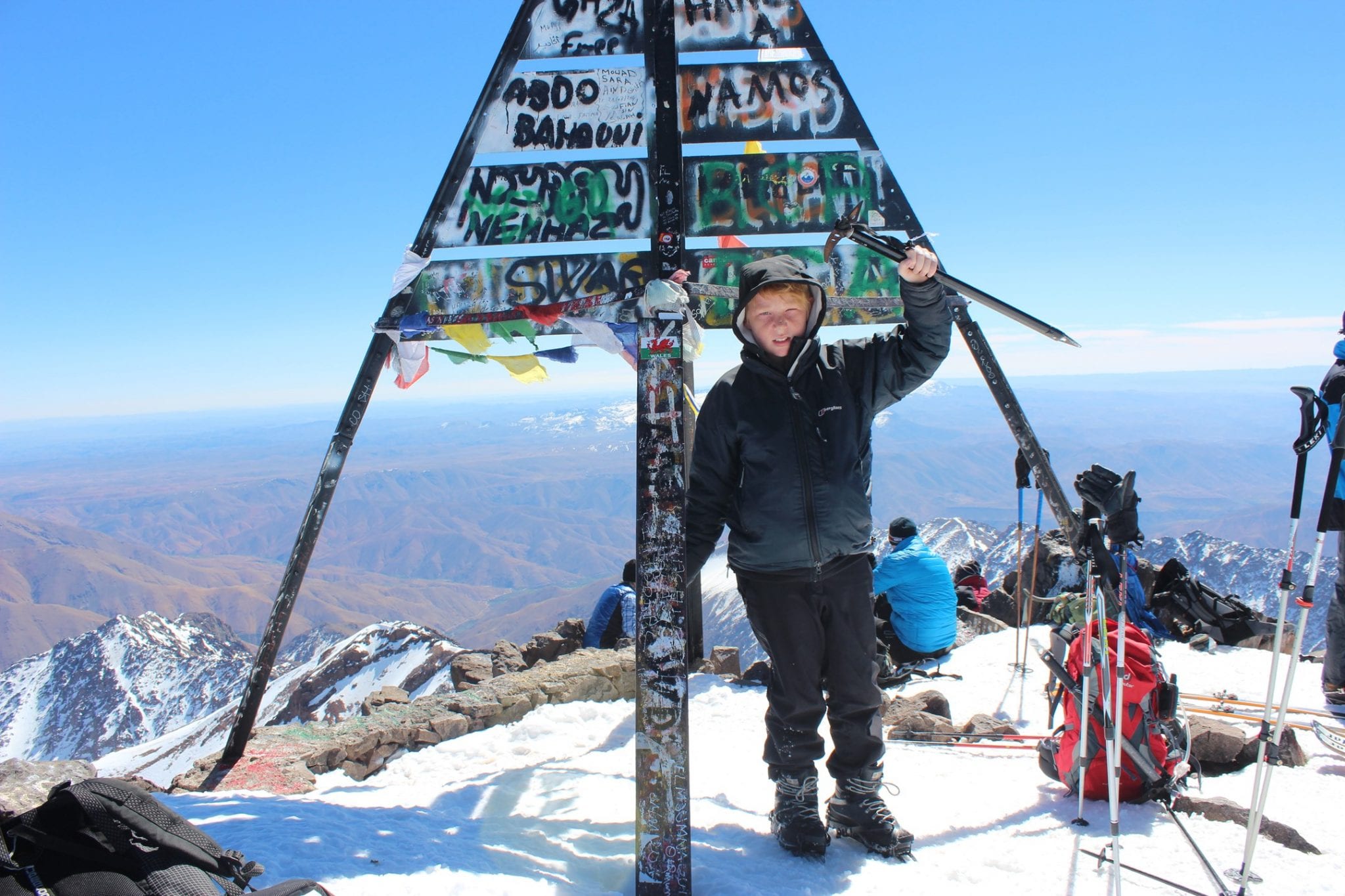

This post is written two-fold. First of all for those who follow the blog and keep up with our adventures. But secondly for those floating around the net looking for information on climbing Jebel Toubkal in the High Atlas:
Introduction
Last summer I attempted a summer ascent of the highest mountain in North Africa – Jebel Toubkal. Due to various issues including 40 degree heat, my daughter suffering from altitude sickness and pretty much being ill prepared, we failed.
This year when my sons 13th birthday rolled around I sat speaking with him about it was his first landmark birthday and one which signified the change from boy into teen. I explained that we ought to do something special, something he could remember, that when he was older and all his friends were reminiscing on a patchwork of insignificant parties all merged into one wonder, he would be able to say “for my 13th I (insert something special)”. After a few days of deliberation Charlie approached me and asked “dad, can we climb Toubkal together, but this time get to the summit”. I was instantly on it, and after a few minor logistical fathoms it was on. In the school holidays of the February half term we would head back to Morocco and attempt what we had previously failed.
Getting to Toubkal
First of all let me clarify something – Lonely Planet claims that Toubkal is a non-technical mountain achievable by those with reasonable fitness. In winter this is simply not true. It is incredibly difficult, we saw people try and fail.
The going rate for a Grand Taxi in Marrakech to Imlil is currently (February 2015) 300Dhs on the basis that as a 6 seat car it can carry 6 passengers at 50Dhs each. The reality is getting the car for 300 is a struggle and it took a fair bit of hassle to secure this. I later found out that 400Dhs will likely seal the deal much quicker. For those unable to get a car, take the bus to Asni and then catch a taxi up to Imlil. This is by far the cheapest option, but with all your gear not the easiest.
Staying in Imlil
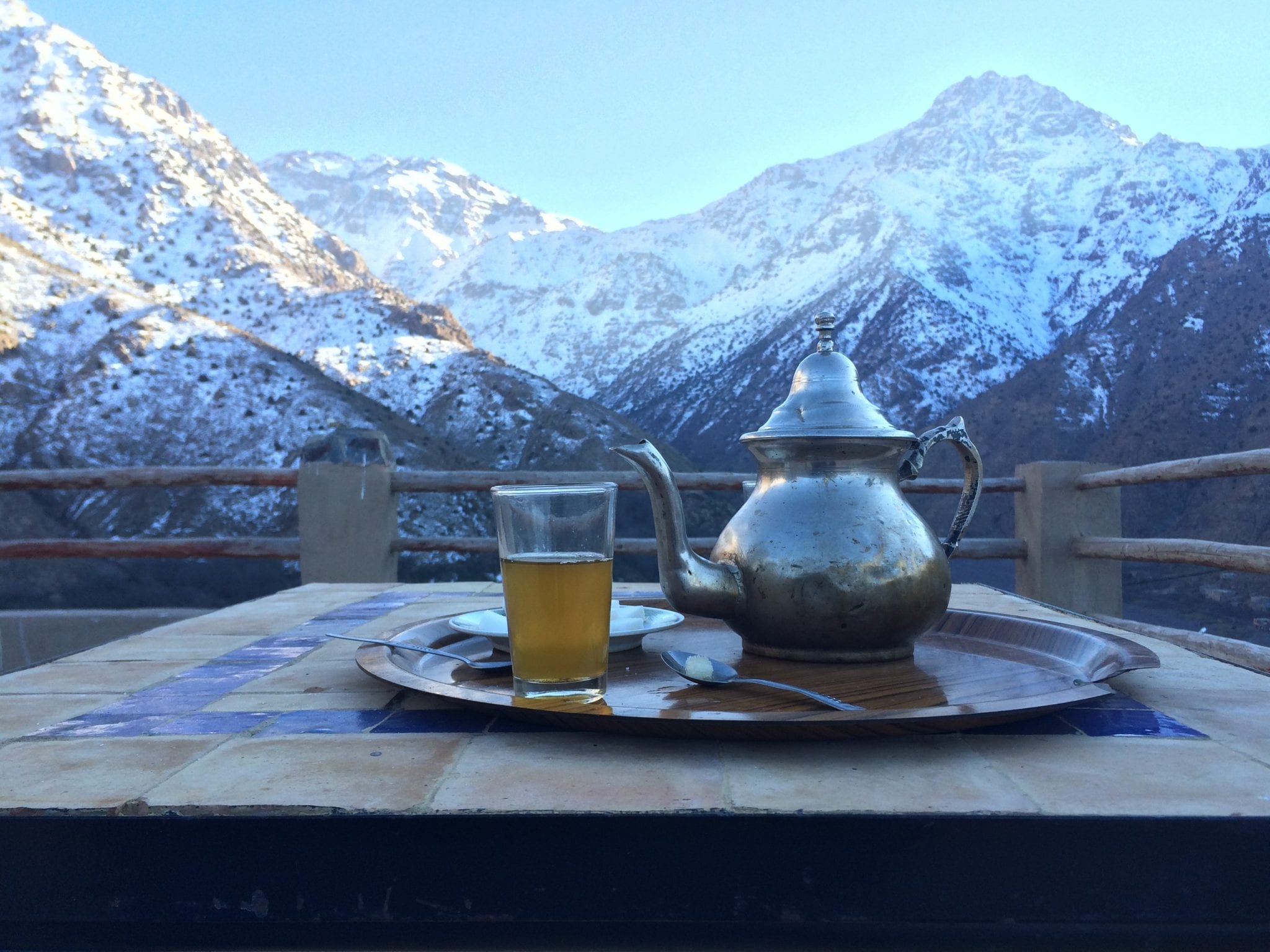

Most hikers start their hike in Imlil. I am going to go against the grain and suggest staying in Aroumd, a village further up the hill with stunning views over the mountains. The reason is simple, by staying in Imlil you are giving yourself a good 30 minute hike of pure up-hill-ness before you even reach the start of the Toubkal hike. We chose to stay at Roches Armed, a fantastic place (and one of the closest places you can stay to Toubkal). The evening before the hike we were the only ones in the place, sat by the open fire, swigging back a few shady Vodkas watching a movie on the tablet. The owner couldn’t do enough for us and as we sat drinking mint tea upon our arrival looking out over the mountains thing felt perfect for a while. I think we paid about 30 euros for the night but it was worth every penny.
If you are looking for a longer hike through the High Atlas to Toubkal, check out the guide from MountainIQ.
Equipment
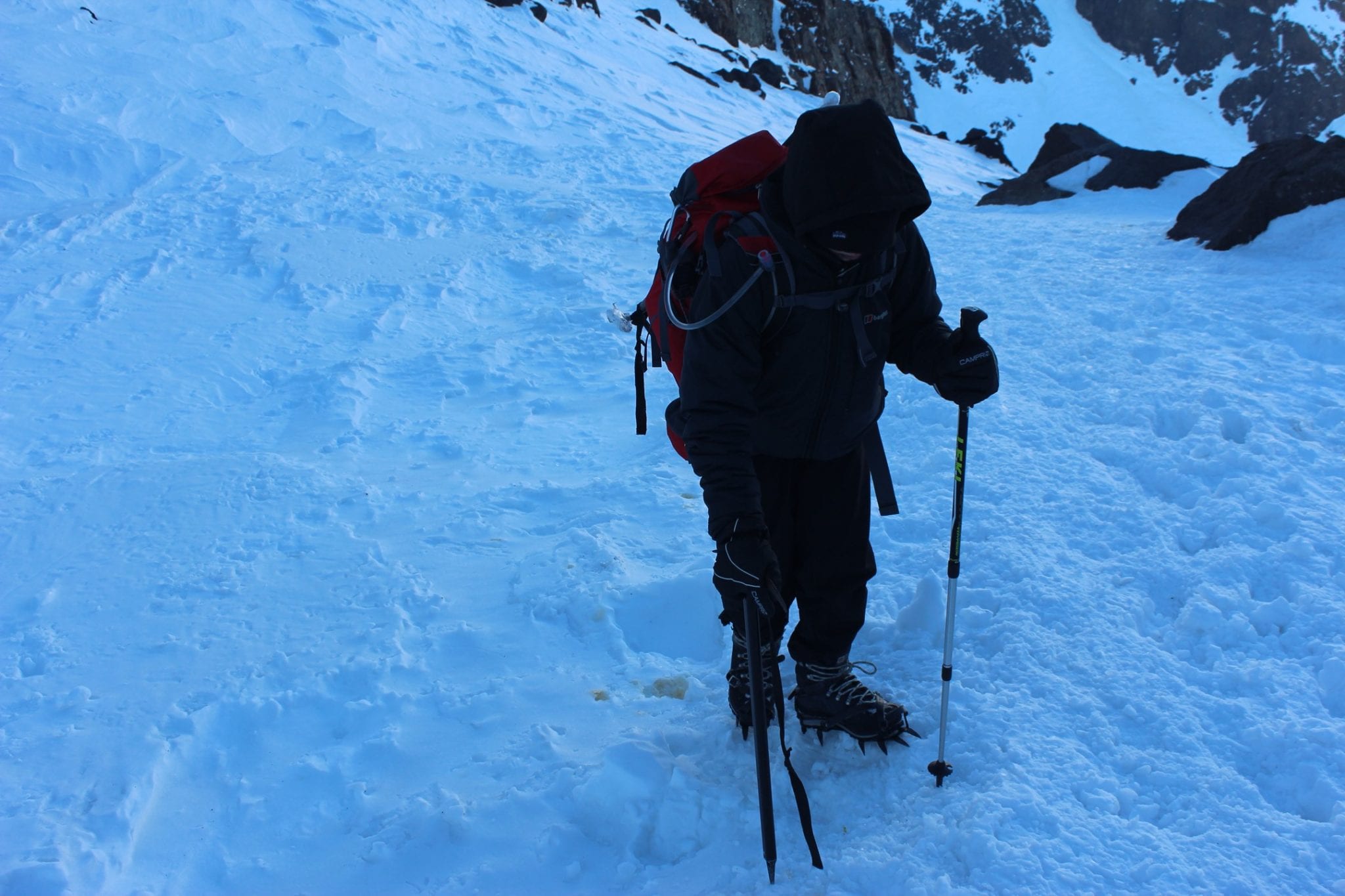

It is no secret, you can hire everything in Imlil or even at the guest house we stayed at. There are crampons and ice axes hanging from every store, you can hire boots, down jackets, everything. The going rate seems to be around 2 euros per item per day. But with a bit of haggling you will no doubt strike a deal.
We decided to take everything, this was our list, including actual items:
- Good mountain boots (Scarpa Manta & Raichle GTX)
- Gaiters (Tog 24 Gore-tex)
- Soft Shell trousers (Mammut Bask)
- Gore-tex trousers (Berghaus Helvellyn)
- Base Layer (RabMeCo 120 Long Sleeve)
- Softshell jacket (Montane Sabretooth)
- Insulated Jacket (Montane Prism)
- Goretex Shell (Berghaus Cornice II)
- Windstopper Hat (Lowe Alpine)
- Gloves (Outdoor Research Stormtracker)
- Crampons (Grivel)
- Ice Axe
- Walking Poles (Leki Voyagers)
- Socks (2 pairs of Merino wool hiking socks)
- Water Reservoir (Osprey Hydraulics 3Ltr)
- Sleeping bag (Mammut Montana 4)
The sleeping bag added about 2.5kg each to our bags and really wasn’t needed since the refuge give you blankets. But I wasn’t aware of that at the time.
Conditions
Weather on Toubkal is notorious for being savage. We kept an eye on mountain forecast (http://www.mountain-forecast.com/) before our climb and I have to say it was exactly as forecast. Every year people are injured on Toubkal and sadly people do lose their lives, such is the terrain and risk involved in a winter ascent.
The conditions for our ascent from the refuge (day 2) were:
- Minimum Temperature: – 12 (wind chill -18)
- Maximum Temperature: -2
- Wind: 20km/h
- Clear Skies
- No snowfall
- Snow line 2,300m
Just two days before winds were around 80km/h and the chill was -26 degrees. Every single ascent was aborted in the 2 days before we arrived.
Costs for the ascent
Hiking up Toubkal carries no costs whatsoever if you choose to either do it in one day (not possible in winter) or camp (difficult in winter). We didn’t use a guide, or a mule or porter. But we did stay at the French refuge. In speaking with a guide I asked the prices and he explained that pretty much they are fixed in Imlil. You can rock up without a single thing booked and you are guaranteed to be met from your taxi with people offering their services. Imlil is not like Marrakech, it’s a very gentle village with absolutely zero aggression. Don’t be afraid to plan on turning up and sorting your trek on the spot. It is easily the best and cheapest way to do it.
- Guide: 300Dhs per day
- Mule: 120Dhs to the refuge, ONLY to Sidi Chamharouch in winter.
- Porter: 120Dhs per day.
French refuge Costs (all fixed)
- 125Dhs for a dorm bed.
- Dinner (all you can eat) 75Dhs
- Breakfast: 50Dhs
- 1.5L water: 10Dhs
- Coke: 10Dhs
- Chocolate bar: 10Dhs
The refuge is heated in winter and very relaxed. We left without paying for ascent and left our sleeping bags and a few other items. We also grabbed a few bottles of water and literally, when we got back to the refuge the manager asked what we had taken when working our bill out. Every single person and guide we spoke to said that the French refuge was by far the better place to stay. However, a few steps away is the Moroccan refuge (Mouflons) We walked in their first and was told it was fixed pricing at 23 euros each for half board. There was a huge sign saying no alcohol allowed, but alcohol was allowed (though not served) at the French refuge. If you want a drink, bring your own.
The ascent – Complete GPX file can be downloaded here – It is tried and tested by myself.
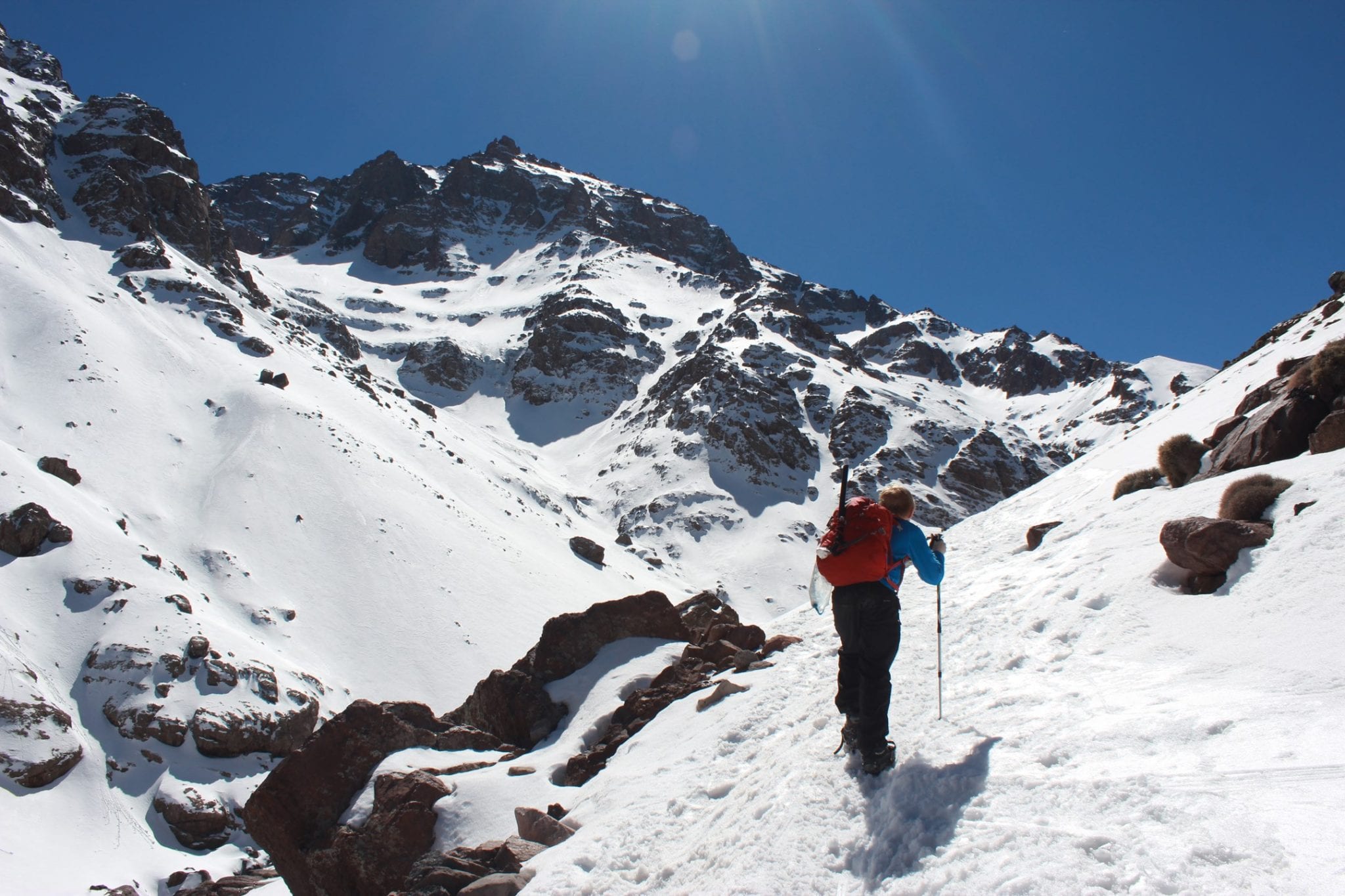

The vast majority of people do what we did, which is:
- Day one: Travel to Imlil/Aroumd stay overnight.
- Day two: Hike to the refuge.
- Day three: Hike to the summit, return to Imlil, return to Marrakech.
You can easily cut out day one and take an early morning taxi from Marrakech then hike straight up to the refuge. Or, you can do what many people do and make your way to the refuge and then just hang about until you feel a spike of energy.
For the purposes of this article I will detail the ascent according to what we did.
Day one
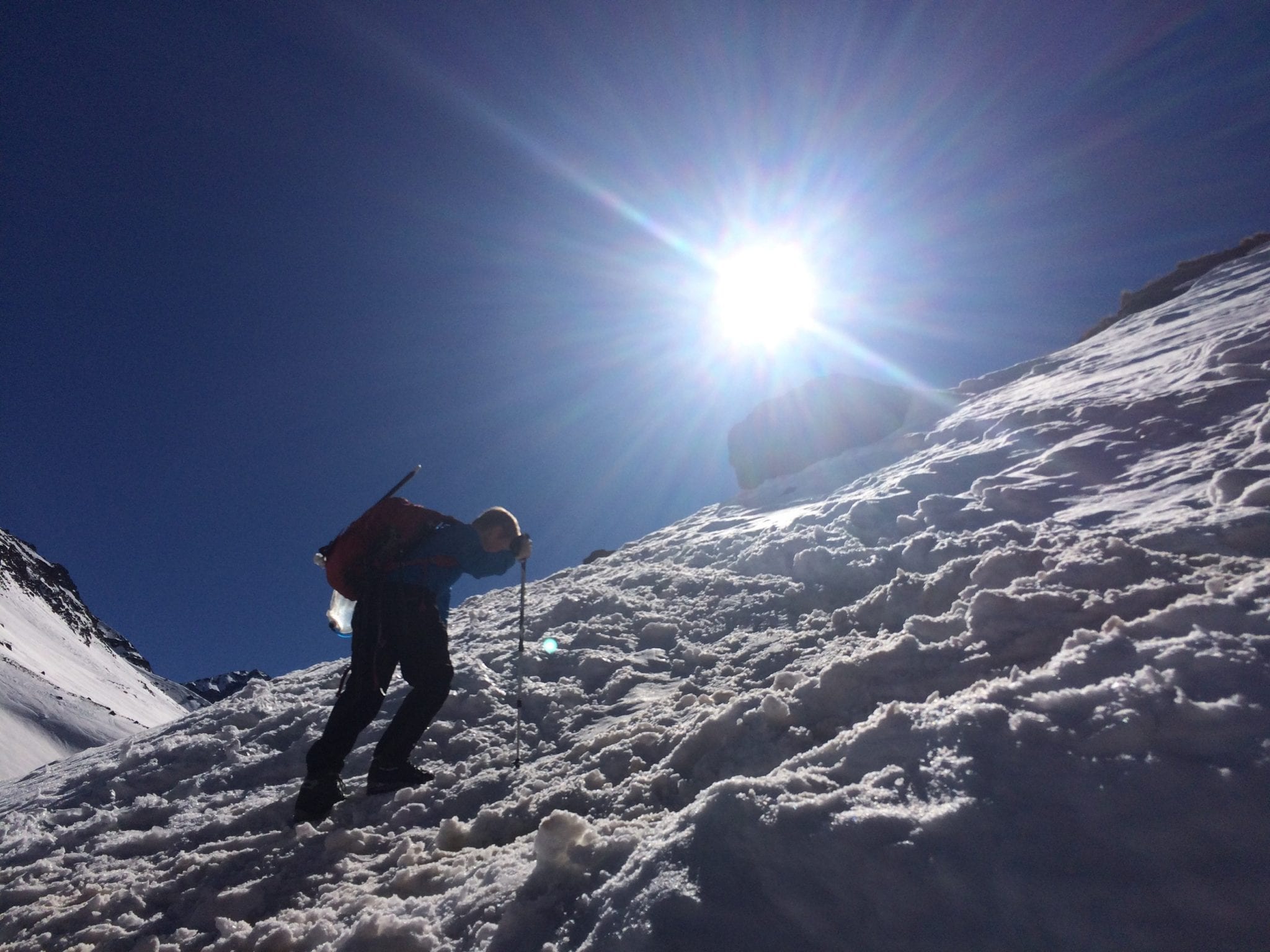

We had stayed the night in Aroumd and woke up around 9am, had breakfast and then set off for the refuge. My timings are extreme, I knew we had until 5pm before the sun set so we chilled out during the hike. The average time is 6 hours. It took us a little longer.
Aroumd is separated by a river into two parts. The village is what you see hanging onto the hillside, the other half is along the road to the glacier flow. The flow is basically a large area of rocks, you can walk straight over it or follow the rocks with silver spots on them. After around 20 minutes you will reach the footpath up Toubkal.
The hike starts out pretty steep, but after around 30 minutes becomes more gradual. You are following the valley up towards the sacred shrine at Sidi Chamharouch. The path is frequented by the occasional porter or mule who will likely offer you their services. In my honest opinion, since the mule only goes to Sidi Chamharrouch in winter it is pointless. If you cannot carry your gear that far, you will struggle further on. After about 90 minutes you will come to a small village, which really is just a bridge and a collection of places that will offer you drinks and food. All charge 10Dhs for water or coke, bread is 2Dhs. All are manned by good people who spend their lives working the tourist trail of Toubkal. The shrine is out of bounds for foreigners, but you can have a look if you like.
From Sidi Chamharouch the path zig zags uphill for a while before becoming the gradual and relentless uphill slog it continues to be until the refuge. You have switched directions and the sun will set earlier behind the mountains to your right. It is actually quite noticeable how cold it becomes when the sun drops behind the cliffs. For us, the snow started at around 2,300m – Just above Sidi Chamharouch. Putting crampons on was quite pointless since it was ‘wet’ snow that had been exposed to the sun all day and though slippy, fairly easy to hike in.
Between Chamharouch and the final resting place there are two places where you can buy drinks (10Dhs) but only one was open during our ascent. Eventually, for normal pacing, after 5 hours you will come to a brick hut with a thatched attachment, this is your last stop before the refuge. But the prices are the same so don’t feel the need to stock up. A short, steep hike upwards brings you to where you can finally see the refuge. You are now a long, drawn out painfully long 1 hour away from where you want to be. By this point we were absolutely beat, we had our crampons on and every step just seemed like it was too much effort. Seeing the refuge in the distance only makes things worse and it took everything from us. The snow was near impossible to hike in and I went over on my ankle a number of times as the wet snow collected in my crampons and made them like ice skates.
Arriving at the refuge was every bit as amazing as I had hopeful. Charlie and I quickly ate tea which was lovely and really wholesome before calling it a night around 8.30pm for a 5.30am start the next day. People complain that the refuge is freezing cold, but honestly we were both fine. Probably due to the fact we had good sleeping bags, but the cold for us was not an issue at all. We did however have minor altitude issues.
At 3,200m the refuge is well over the 2,500m altitude ceiling and we both suffered similar symptoms. Increased heartbeat of around 120bpm was persistent most of the night, as was a headache similar to that of dehydration. Paracetamol quickly quelled the headache. By the morning only the headache persisted, our heart beats had regulated themselves back to normal.
Day two
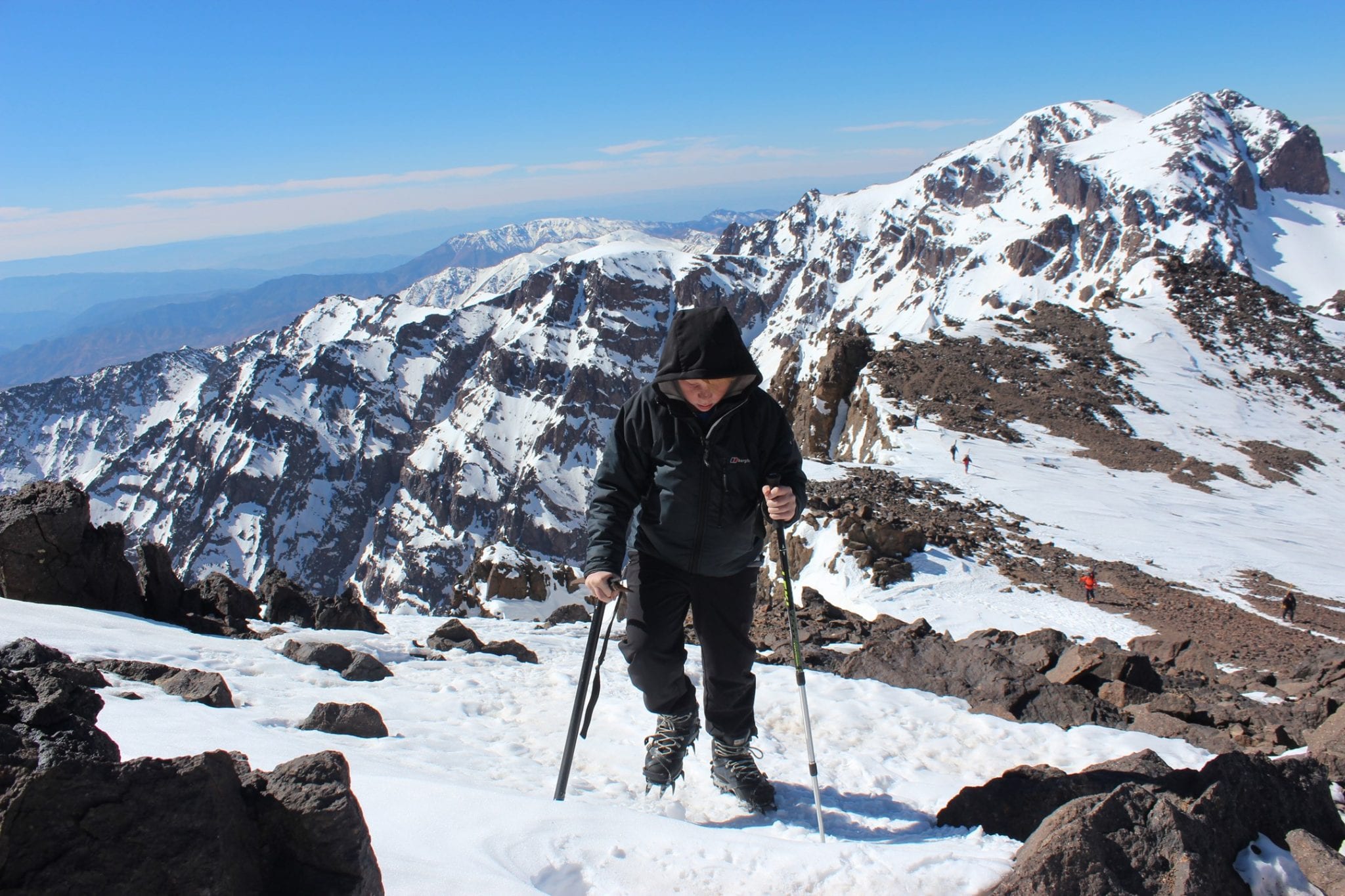

We chose for a 5.30am ascent for a number of reasons. Firstly, the snow would be frozen over on the surface making for a much easier hike with the crampons on. Secondly, I didn’t want to rush but knew we had to be back in Marrakech that night. And thirdly, once the sun rose over the mountains we would be exposed to high levels of UV. I secretly admit to a fourth reason which was that we wouldn’t be able to see where we were going!
The ascent from the refuge in snow is awkward in that you have to deviate from the GPS route. But it does mean you can literally hike straight up the slope knowing you don’t have to worry too much about scree. Looking up from the refuge you will see a false summit. To give you an idea of what is ahead, the top of that is about 1/5th of the way. I was told that the first hour of the 4 hour ascent (3hr in summer) was the hardest, and that the remainder was less so. It is absolute rubbish. From the second you step out of the refuge, to the second you reach the summit you are grinding out a constant uphill which must be 70 degrees at angle. I know people think that would be an exaggeration, but honestly, that hike up from the refuge was wiping everyone out. Combined with the altitude, it was an absolute killer hike. Actually, without the altitude it would still be a harsh climb.
I cannot offer any tips on the hike, just to rest regularly, and keep going. When you reach a small plateau you will see before you a ridge, you are about 1hr from the summit. Once at the top of the ridge it was a precarious and quite tricky hike, to the right is a cliff face of a few thousand feet, to the left is an 80 degree slope. You are now hiking on a path covered in ice and snow and less than a foot in thickness. A slip would mean broken bones at the best. I spoke to a guide who told me that during winter around 30 people per month need rescuing due to breaking their bodies in falls, 1 person has died this year already and about half of all summit attempts fail or get called off due to weather.
You can see the metal pyramid that signifies the summit from some way back, but nothing beats that final hike to touch it. By that I mean that, on the entire hike to the summit you are either in a valley, or hiking along the side of a mountain surrounded by other mountains. But suddenly the whole world just falls away and you are hiking on a small piece of snow which could be the top of the world.
Reaching the summit was something I wasn’t sure we would do. My breathing was fast, my body was aching and as I cuddled my son I wished him happy birthday and could feel tears of joy and relief pouring down my face. Charlie looked at me, smiled and hugged me. Together we had achieved what had been at times near impossible. It was the hardest thing either of us had ever done and it had taken everything from us. It was a grueling two day hike that tested every part of us.
As we stood looking at the spectacular panorama around us a guy from a French group that had passed us came over, shook my hand and congratulated Charlie. He pulled a silver whiskey flask from his jacket and told me it had 45 year old whiskey in it, he takes a swig every time he summits a mountain. He passed it to me, I had a small drink and looked around at the 8 or so of us that had made the summit. To me they all looked like professional Alpinists, and as I looked at Charlie I was overcome with immense pride.
We had done it, it had been almost impossible – But we had done it.
Descent
Getting down the mountain via a short stop at the refuge took us about 6 hours, but this was largely due to the fact that getting to the refuge took so long as the snow was wet and it was a nightmare to get down. On the way back down the mountain we passed people all making their way up and each anxious to know how long was left, how hard it was, or what the conditions were like. People looked surprised when they knew a 13 year old had summited and I was so proud to know we did it together.
Once at the bottom of Toubkal we were completely wiped out. The energy we had was gone, the life within us sapped out and every step was a brutal necessary that we couldn’t avoid.
The last hour was in darkness and walking towards Imlil I was desperate to get back to Marrakech. A car came towards us with full beam headlights and I waved him to stop. The driver wound the window down and I asked straight out “brother, I will give you 300 Dirhams, please take us to Marrakech”. A bit of haggling ensued and we eventually settled on 400 Dhs. It was 8pm and both Charlie and I were completely broken.
The remainder of the evening is a blur, but sitting on the plane the next morning as it thundered down the runway, I looked at the High Atlas piercing the sky in the distance. My eyes welled up as I looked over what my son and I had achieved. It had been the hardest thing we’d ever done, but it was worth every step.
Happy Birthday Charlie – You’ll never know just how proud you made me x
If you are heading to the High Atlas without kids, or are looking for a longer hike through the region, MountainIQ have a great page that is certainly worth checking out: Climb Mount Toubkal

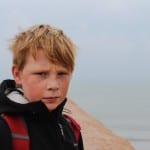

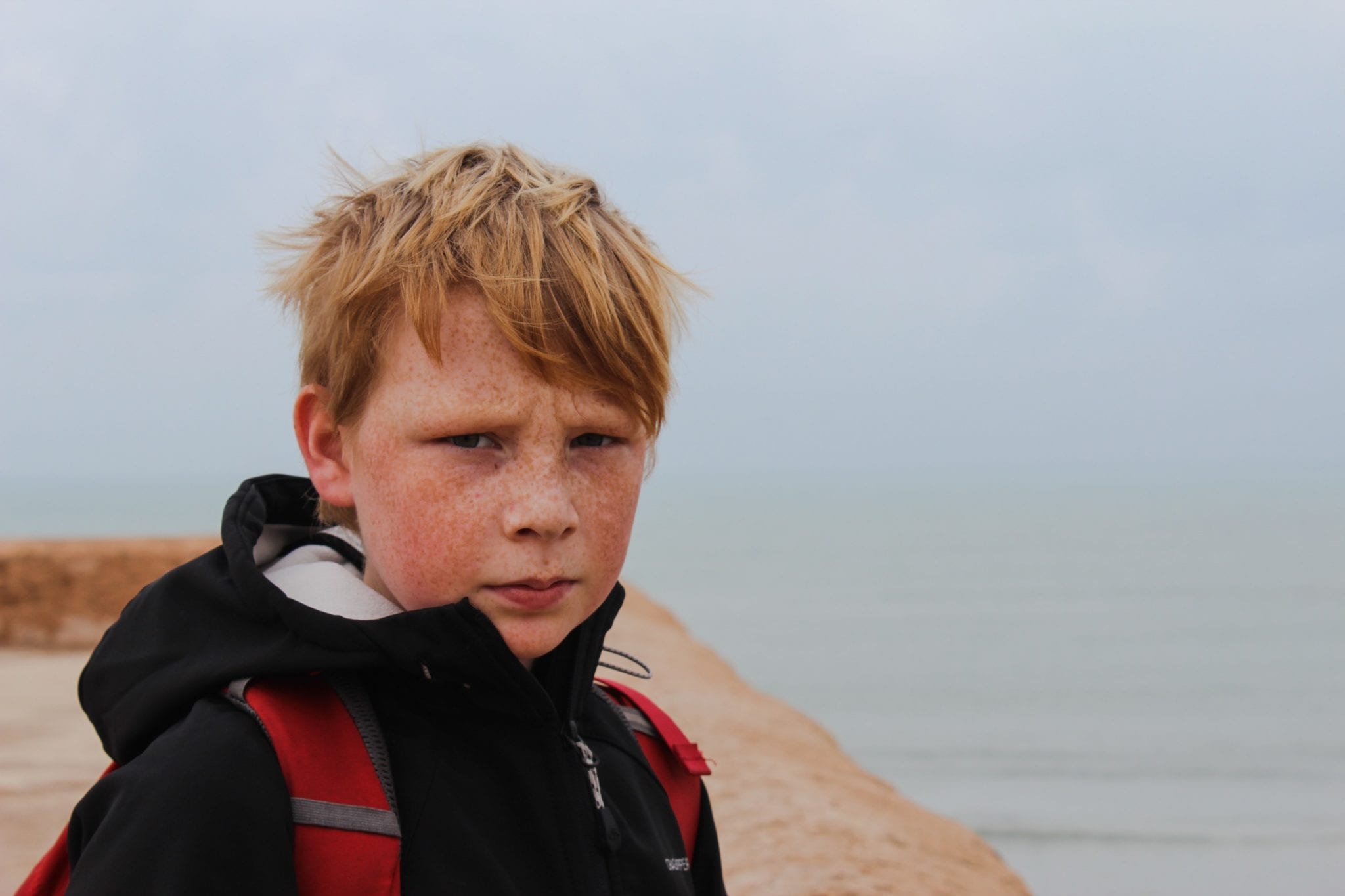
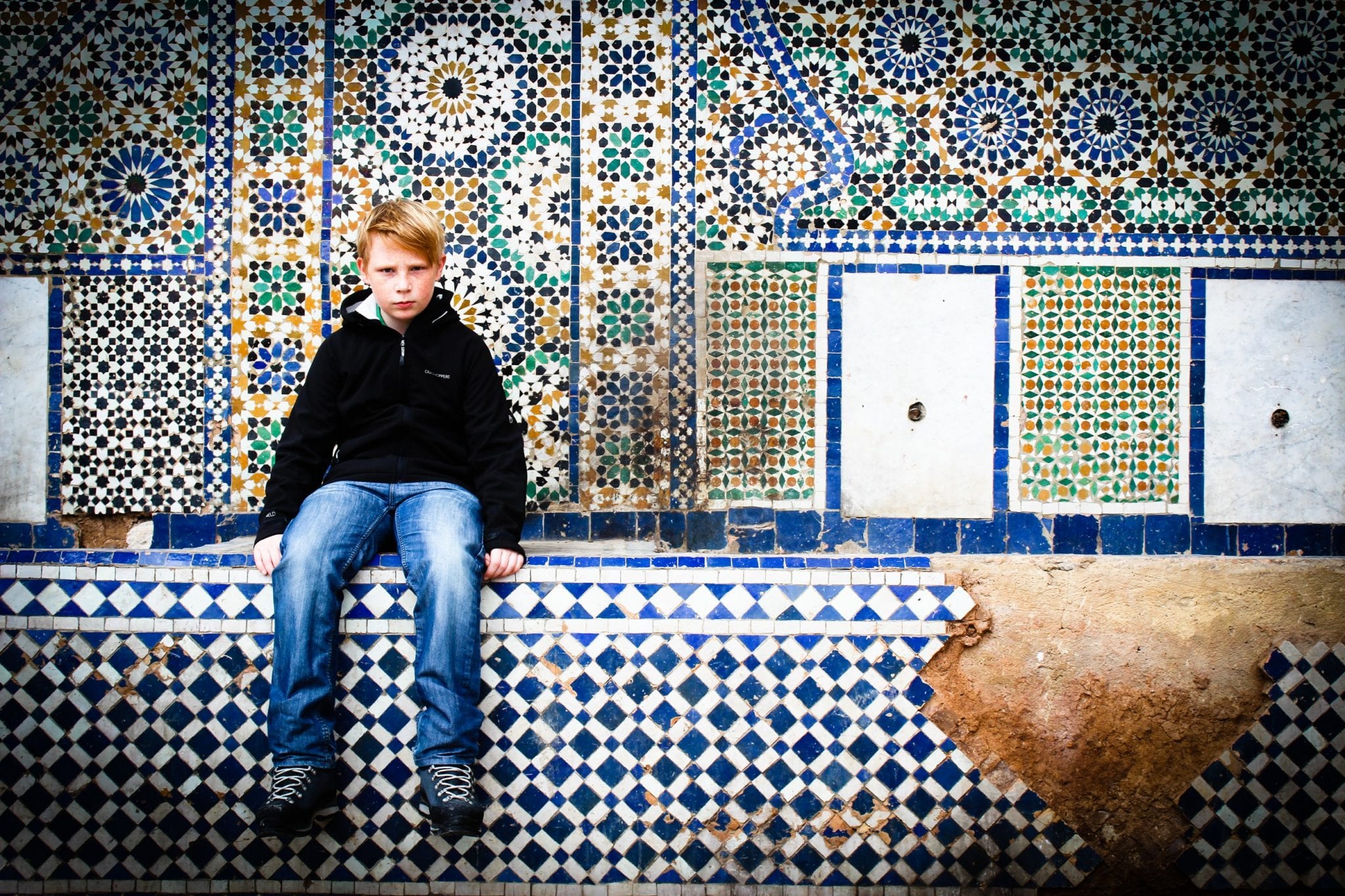
Comments are closed.